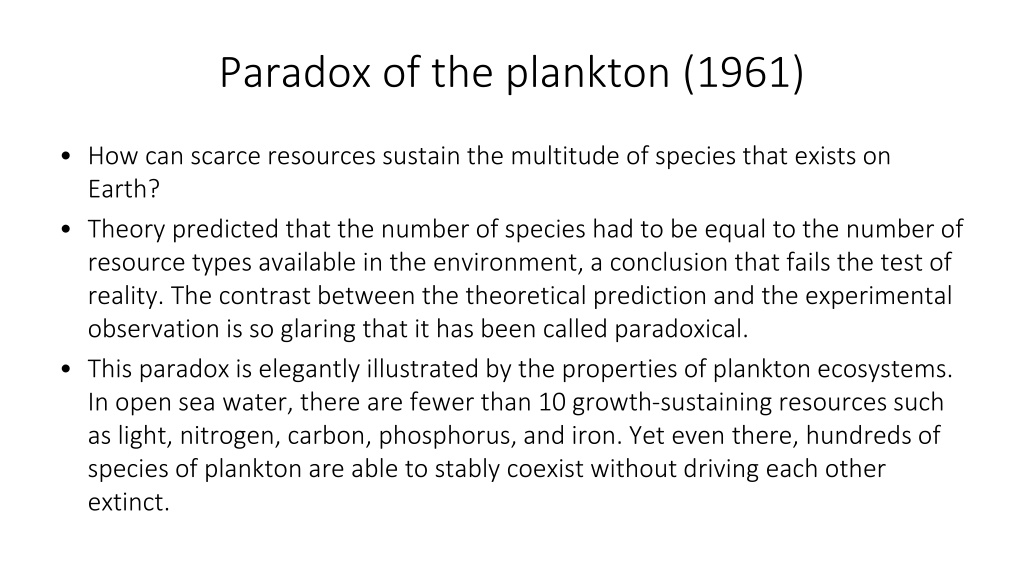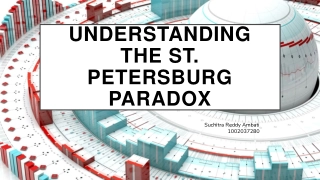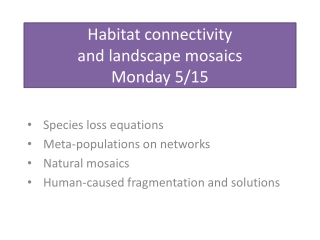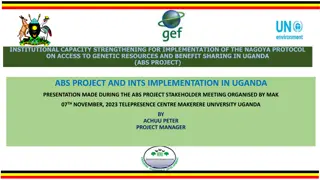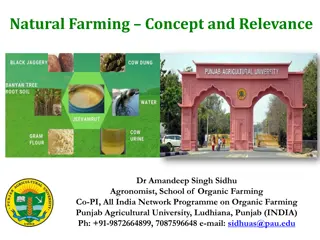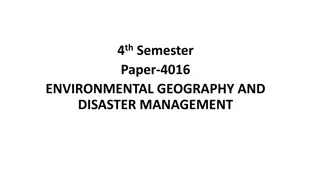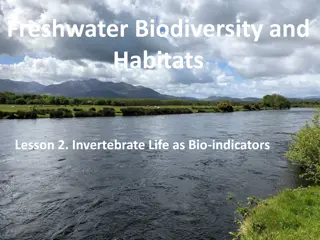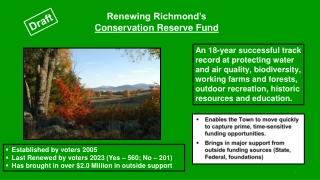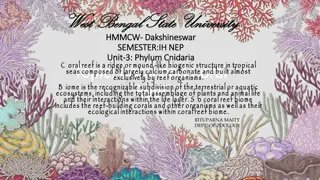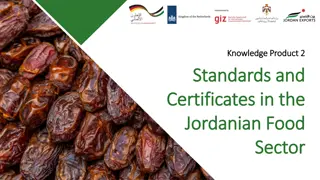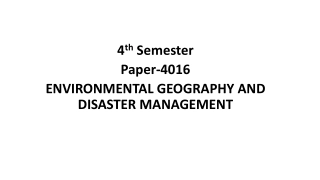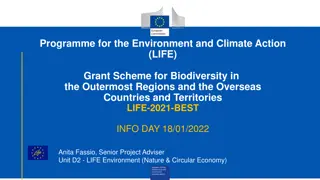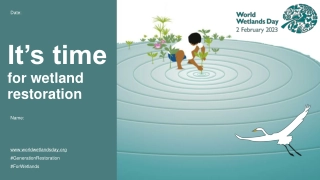Understanding the Paradox of Plankton and Biodiversity Correlates
The paradox of plankton challenges the theory that the number of species should match available resources, as seen in diverse plankton ecosystems. Explanations include resource partitioning, temporal and spatial heterogeneity, predation, adaptation to disturbance, and evolutionary processes. Biodiversity correlates such as area, disturbance, habitat heterogeneity, isolation, and latitude influence species richness. The species-area relationship and the Intermediate Disturbance Hypothesis further shed light on biodiversity patterns.
Download Presentation
Please find below an Image/Link to download the presentation.
The content on the website is provided AS IS for your information and personal use only. It may not be sold, licensed, or shared on other websites without obtaining consent from the author. Download presentation by click this link. If you encounter any issues during the download, it is possible that the publisher has removed the file from their server.
Presentation Transcript
Paradox of the plankton (1961) How can scarce resources sustain the multitude of species that exists on Earth? Theory predicted that the number of species had to be equal to the number of resource types available in the environment, a conclusion that fails the test of reality. The contrast between the theoretical prediction and the experimental observation is so glaring that it has been called paradoxical. This paradox is elegantly illustrated by the properties of plankton ecosystems. In open sea water, there are fewer than 10 growth-sustaining resources such as light, nitrogen, carbon, phosphorus, and iron. Yet even there, hundreds of species of plankton are able to stably coexist without driving each other extinct.
Explanations for the paradox of the plankton: Resource partitioning: Resource partitioning: Different species of plankton have evolved to use resources in slightly different ways Temporal and Temporal and spatial heterogeneity: spatial heterogeneity: The environment is not uniform over time and space. Predation and grazing: Predation and grazing: Zooplankton and fish limit abundance of particular plankton species and prevent any one species from becoming dominant, promoting diversity. Adaptation to disturbance: Adaptation to disturbance: Some species may be adapted to thrive under specific disturbance regimes, such as fluctuations in nutrient levels or physical disturbances. Evolutionary processes: Evolutionary processes: Diversification of traits among plankton species reduces direct competition and over time contributes to the maintenance of species diversity.
Correlates of biodiversity Area Disturbance Habitat heterogeneity Isolation Latitude
Area As area increases, so does the number of species. Originally applied to the study of oceanic islands but is applicable to terrestrial islands as well.
The species-area relationship Species-area relationships are often graphed for islands (or habitats that are otherwise isolated from one another, such as woodlots in an agricultural landscape) of different sizes
Disturbance The Intermediate Disturbance Hypothesis predicts that diversity in will peak at intermediate disturbance frequencies. IDH is a very general model to explain diversity, and holds true in some but not all situations.
Habitat heterogeneity Greater heterogeneity in habitat can contribute to high biodiversity. For example, the most biodiverse states are those that have a large number of habitats, such as California.
Isolation Isolation facilitates speciation, as evidenced in the unique flora and fauna of isolated islands like Hawaii, the Galapagos, New Zealand
Latitude Plant species richness peaks in the tropical latitudes, as do many animal taxonomic groups. This map shows the latitudinal diversity gradient of plants 9
Theories and conceptual frameworks to explain general diversity patterns Niche models Island biogeography theory Mosaic models Neutral models Metacommunity models
Niche-based models of diversity Niches provide a means for species to accumulate Assumption is that each species has a niche More niches = more species
Island Biogeography Theory In 1967 Robert H. MacArthur and Edward O. Wilson published The Equilibrium Theory of Island Biogeography (ETIB). It marked a turn toward quantification in ecology. The theory aims to explain the processes that control the number of species present
Contributions of island biogeography theory: island dynamics applied to conservation Diversity of fragmented islands of forest in Costa Rica can be framed in terms of island size and separating distances among islands
As island size (i.e. fragmentation) decreases: Extinction rate increases Resources become limited Distances between island increases Organisms cannot come in contact with a mate it is useful to avoid fragmentation because fragmentation is almost always linked with habitat loss
The SLOSS (Single large versus several small) debate Insights about the design and management of conservation areas came out of island biogeographic theory. The SLOSS debate is the conversation over the best strategy for designing reserve areas single large or several small. One side of this debate is presented in the figure at right it holds that single large is better and that more edge is a negative.
SLOSS implications for conservation Small patches may be assumed to have no conservation value. Forestry policy may recommend cutting patterns that defragment the remaining forest by removing small patches Landowners and communities may be paid to preserve forest, but only at some threshold size of patches In places where natural habitats are already scarce, these small patches are where the remaining habitat most needs protection
Mosaic theory of biodiversity Holds that several small reserves may not necessarily be detrimental to biodiversity Recognizes that fragmentation should not be automatically equated with negative effects of reduction in size or extent of habitat Low levels of fragmentation can increase species richness for some taxa Having large intact habitats may not always increase species richness
Processes that occur at local patch scalesthe scale of the vast majority of fragmentation studies may not be the dominant processes that affect biodiversity at larger landscape scales.
Critiques of the idea that fragmentation is not bad Fragmentation may increase abundance of disturbance- adapted and invasive species Some people might use findings of positive effects of fragmentation to justify development, logging, or road building We cannot assume that the initial rates of biodiversity change observed at different levels of fragmentation will remain over longer time periods. Extinction debts may accumulate following fragmentation
Neutral-based models of diversity No niche specialization All individuals of a species considered equivalent Many species can occupy the same niche Diversity is a function of who occupies a niche first Dispersal and basic demographics (birth, death) are key variables
Niche Niche- -based models based models - - species diversity arises based on match between species life history traits and availability of its niche Neutral models Neutral models biodiversity arises through the random shuffling of species dispersal and colonization shapes biodiversity Pure neutral-assembly models Pure niche-assembly models
Niche versus neutrality: scale matters (it always does) Their explanatory value also varies depending upon scale extent and resolution
Metacommunity models of diversity Metacommunity many communities linked by dispersal of potentially interacting species interacting species. Diversity measured locally within a community (alpha), as turnover between communities (beta) or regionally across all communities (gamma). potentially
Diversity in metacommunity models is determined by: Local community environmental heterogeneities Local community environmental heterogeneities which favor abundance of certain species through niche processes over others Source sink dynamics Source sink dynamics: net flow of individuals among communities constrains outcomes of species interactions and their abundances Competition Competition - - colonization tradeoffs: colonization tradeoffs: abundance in a local community is a trade-off between being a better competitor or having adaptations that favor colonization Rescue effects: Rescue effects: local community extinction of a poor competitor can be prevented by immigration. Neutrality Neutrality: species abundances are due in part to random processes and dispersal limitation
Complexity definitions of biodiversity Biodiversity is a cause and a result of complex adaptive systems interactions Biodiversity arises out of cross-scale interactions Biodiversity is coupled to systems properties like resilience and stability
What are the relationships between diversity and stability? A very complex question that is very simplified in this lecture Stability can defined in many ways. One way is to define it as the persistence of a function, like overall production of biomass, an ecosystem definition of stability. A population definition considers whether or not the population numbers differ through time. Here are some of the views of this relationship between diversity and stability
High diversity can be associated with population instability Populations in diverse ecosystems are not more stable than populations in simple ecosystems (May, 1973)
High diversity promotes aggregate ecosystem stability but low population stability (Tilman et al 1996) Having many different kinds of species results in more ways to achieve recovery from disturbance or environmental fluctuation (the portfolio effect) Large number of species results in aggregate stability the capacity to retain ecosystem function But population of species fluctuate in abundance when ecosystem stability is high
High diversity is not directly necessary for stability in ecosystem function (sensu Allen and Holling 2010) High diversities and fluctuations in the abundances of populations are mechanisms to evolve ecosystem stability Ecosystem stability may not require high diversity, but is derived from it. Some lower diversity systems may actually be very stable Example: salt marsh (monotypic grass species maintain stable ecosystem functions)
Why do the tropics have so many species? Mechanisms to explain the latitudinal diversity gradient: Climate stability hypothesis Geographical area hypothesis Species-energy hypothesis Historical perturbation hypothesis Evolutionary rate hypothesis Tropical refugia hypothesis Middle domain effect Competition-based hypothesis Tropical conservativism hypothesis
